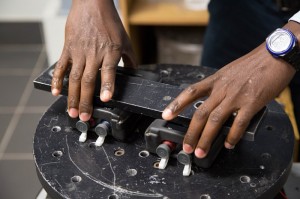 Operational equipment must be qualified to meet the environment it will operate in. Be it prototypes or existing technology, it can be put through various tests in this laboratory. A lot of the work the CSIR does involve the testing and evaluation of operational equipment performed in this testing facility. The facility is a secure environment for exclusive use by the CSIR.
Operational equipment must be qualified to meet the environment it will operate in. Be it prototypes or existing technology, it can be put through various tests in this laboratory. A lot of the work the CSIR does involve the testing and evaluation of operational equipment performed in this testing facility. The facility is a secure environment for exclusive use by the CSIR.
The MIL-STD-810F test performed in this testing laboratory looks at a broad range of environmental conditions that include pressure testing, exposure to high and low temperatures, salt spray for corrosion testing, bump shock and vibration testing, and high altitude testing.
Data gathered is implemented in environmental management and engineering processes that can be of great value to generate confidence in the environmental worthiness and overall durability of a systems design.
Vibration testing
Vibration testing is performed, using a single axis excitation vibration table, on mechanical and electronic equipment to evaluate the equipment’s performance under light to severe vibration conditions. The test item will be tested at a certain level of vibration for a certain duration, before being transposed to another axis to ensure all axes are tested. The laboratory is able to expose equipment to vibrations emanating from different modes of transport, which includes simulations such as a car driving on gravel road, a vessel travelling on water, a soldier running or walking and an aircraft travelling at different speeds.
Pressure testing
The environmental laboratory has three different types of measuring apparatus used for pressure testing. During one such a test, the equipment is exposed to water, at various pressures to simulate depths underwater.
During another test performed at this facility, small equipment is placed in 0.5 bar vacuum, if the pressure within the Item under test decreases, it shows that the equipment is not properly sealed .
A 4.2 m deep and 2.77 m in diameter water tank is also available, where a diver with his full military kit can be completely submerged and monitored for air bubbles to look for potential water leaks. For a stealth diver, water bubbles is a serious threat as it can compromise his mission by indicating his presence.
Corrosion testing
Metal oxidation is a common form of corrosion that can lead to serious structural deterioration. By knowing how long certain pieces of equipment can be exposed to salt water, corrosion can be avoided and the lifespan of the equipment prolonged. A salt spray facility is available at the CSIR that is used to test how susceptible equipment is to corrosion. By exposing the equipment to a 5% brine solution spray for up to 40 hours, it can be determined if components start to corrode.
Drop testing
The CSIR has a drop test rig, where equipment is placed on the drop tester and remotely dropped from a height of 1,2 meters. Testing on electronic equipment is performed here to see if it meets the specification requirements.
Climate and temperature testing
The environmental laboratory has two different types of apparatus that expose electronic and mechanical equipment to changing temperatures and humidity cycles. Bigger equipment can be placed in an ‘oven’ able to expose the equipment being tested to temperatures from – 50 degrees Celsius to 70 degrees Celsius. The humidity testing is done on smaller equipment on an apparatus that changes the humidity in cycles, also varying the temperatures form -30 degrees to 70 degrees Celsius.
